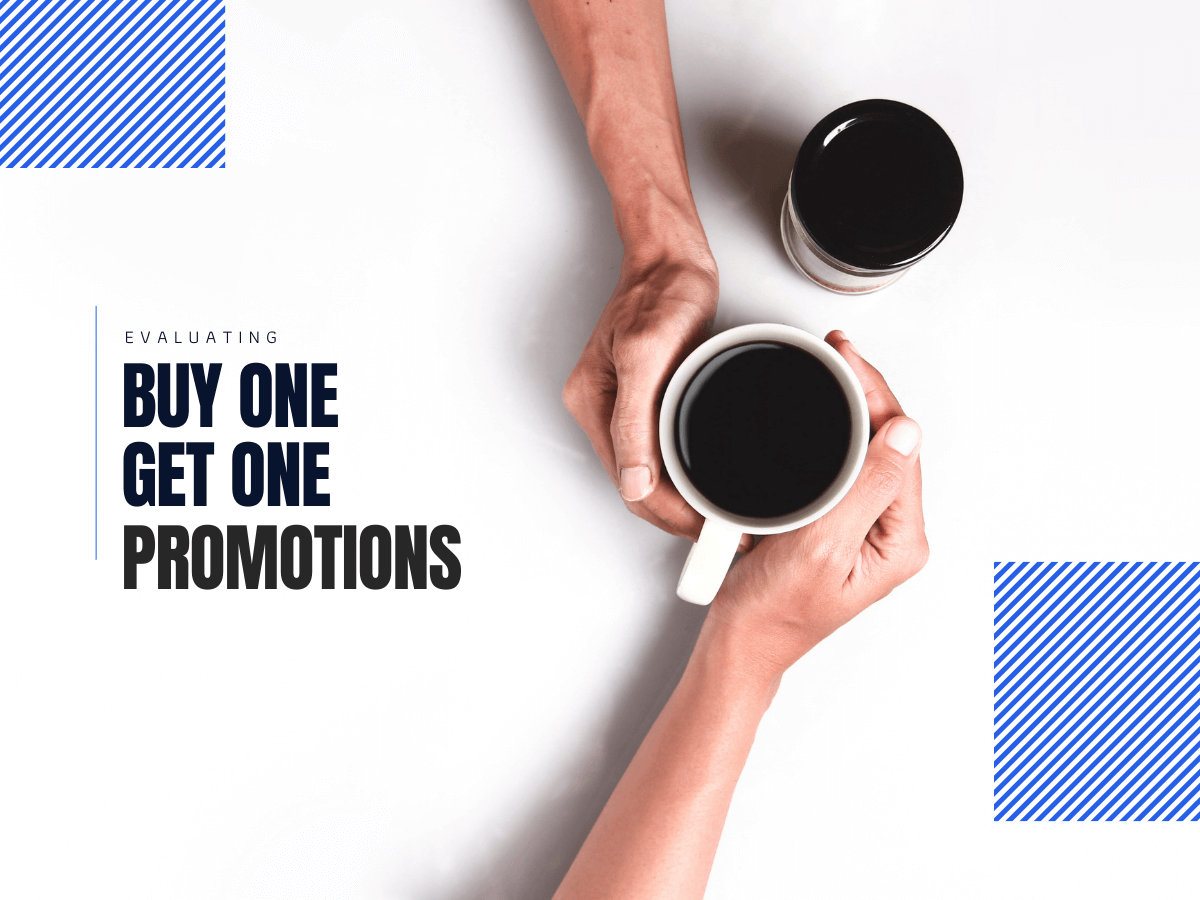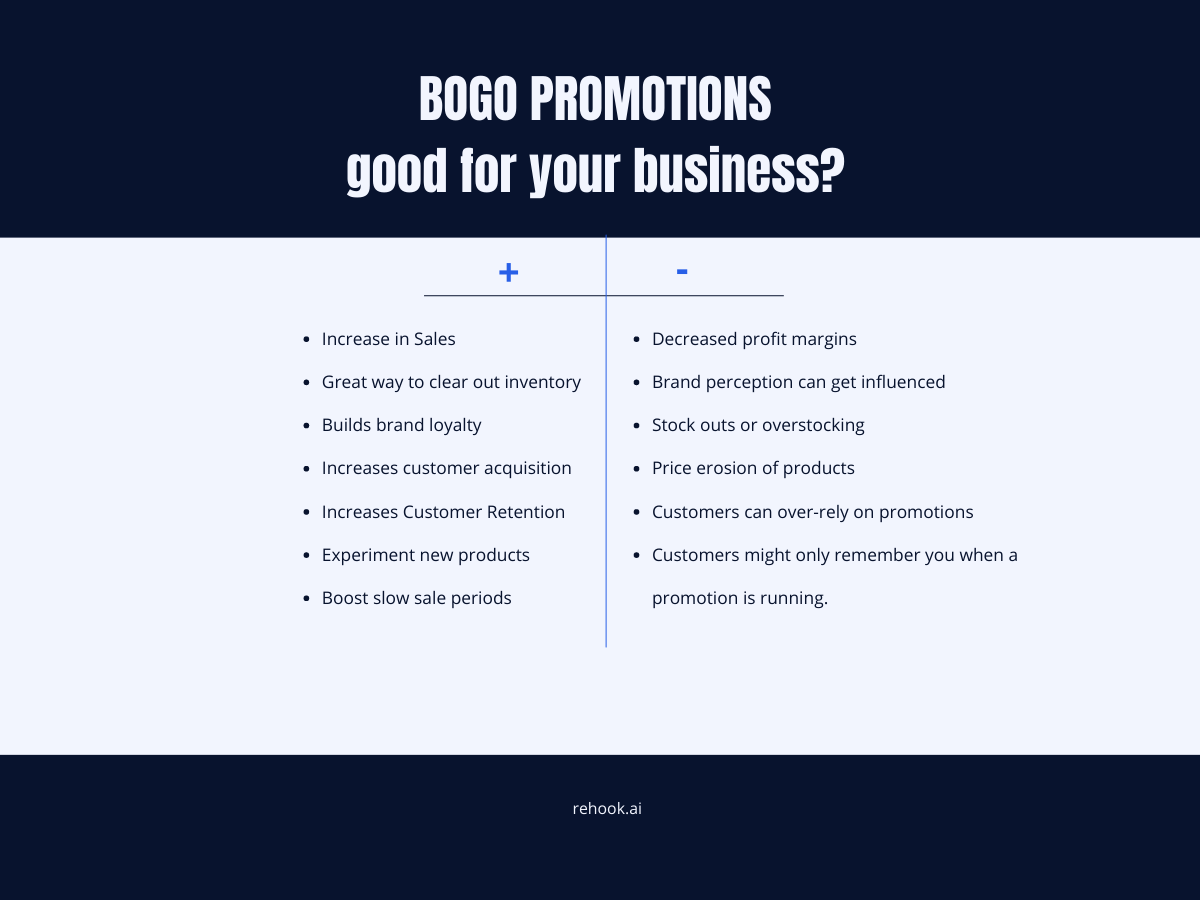
BOGO Promotions: Meaning, Pros and Cons For Businesses
BOGO promotions are the third most popular type of promotion among consumers and can increase sales by 90%. Explore what BOGO means, the benefits and how to effectively implement the strategy in your business.
We're living in the world of digital, where the competition is getting increasingly fierce and customers have endless options to choose from. As a consequence, businesses are now prioritising promotions more than ever to stand out and keep their customers coming back for more - and one of the most popular promotional strategy is the "buy one get one" or BOGO.
With the changing needs of the customers, it has become even more crucial for businesses to evaluate BOGO promotions and if they really add to their growth.
BOGO promotions are the third most popular type of promotion among consumers and can increase sales by 90%.
BOGO promotions : A deal or steal?
The origins of BOGO promotions can be traced back to the early days of commerce and retail, when store owners would offer customers a free item with the purchase of another. These type of promotions were typically used to entice customers to purchase more items, and were especially effective during slow periods or to promote new products.
Today, BOGO promotions have become even more prevalent, as businesses have adopted the strategy for it's many lucrative benefits:
- Increases customer traffic and sales: Customers are attracted to the opportunity to get a second item at a discounted or free price, which can lead to increased or repeat purchases.
- Helps clear out stale/ overstocked inventory: Offering a free or discounted item with a purchase can encourage customers to buy items that may not considered in the past.
- Increases brand awareness and loyalty: BOGO promotions encourage customers to try new categories, products or services. It can also create a sense of urgency, which can lead to repeat customers.
- Attracts new customers: BOGO promotions can be an effective way to attract new customers, as they offer an incentive for people to try a business for the first time.
- Up-Sell/ Cross Sell other products: A great opportunity for businesses to upsell or cross-sell related products. For example, a clothing store might offer a buy one get one 50% off promotion on a specific clothing item, and then offer a discount on a related accessory or say, a variant.
- Provides valuable data on customer purchasing behaviour:Businesses can collect valuable data on customer purchasing behaviour. By tracking which items are being purchased together, businesses can gain insight into customer preferences and make data-driven decisions about future promotions and inventory.
- Can be used to test new products or promotions: By offering a free or discounted item with a purchase, businesses can gauge customer interest and make informed decisions about whether to continue offering the item or promotion in the future.
- Provides an opportunity to increase average purchase value: By offering a free or discounted item with a purchase, customers may be inclined to buy more items or higher-priced items.
- Can be used to boost sales during slow periods: By offering a deal, businesses can attract customers and increase revenue during the slower times like off-season deals etc.
Considerations to take into account before running a BOGO promotion:
- Risk of decreased profit margins: As businesses are essentially giving away one product for free or at a discounted price, they risk cutting down their own profit margins. Therefore, it is important to carefully evaluate the cost of the products being offered in the BOGO deal, as well as the potential increase in sales, before making a decision.
- Can lead to a decrease in perceived value: Customers may come to expect discounts and deals, and may be less willing to pay full price in the future.
- Difficulty in managing inventory: BOGO promotions could lead to stock outs or overstocking, depending on the sales projected vs. actuals.
- Other expenses: Such promotions could require additional marketing and advertising efforts to promote the deal.
- Customers can get confused: If the customers do not understand the terms and conditions of the deal, or may not know which products are eligible for the promotion, the strategy will not change their behaviour.
- Can damage the brand image: BOGO promotions can damage the brand image and its perception, if the discounts are too frequent or if the discounts are too steep (Unless, that is what the brand intends to do). BOGO deals can be perceived as a sign of a business being in financial trouble, or as a "desperate" move to get customers in the door. Therefore, it is important to be strategic in how and when you offer BOGO deals, and to ensure that they align with your brand and overall marketing strategy.
- Can lead to a decrease in customer loyalty: If customers only reach out to the business when a promotion is running, they are not loyalists- they are simply there for the deal!
- Risk of a decreased perceived value of products: Customers can get accustomed to getting a discount on the a particular product or service because of BOGO promotions.
- Chances of price erosion: Such promotions can lead to price erosion, which means the value of products becomes less and less over time, and it can be hard to raise prices again.
- Over-reliance on promotions: Businesses may become reliant on such promotions to drive sales and may lose sight of other important strategies such as improving customer service or increasing product quality.

Making the right BOGO cocktail for your business
It is important that your BOGO promotions are planned and strategised according to your overall business goals. As a business, you must consider several variations to your BOGO strategy, and see what aligns with your growth metrics. Accordingly, tailor the campaign to gain more control over the impact on the bottom line.
Here are some of the popular BOGO variations and types:
- Buy One, Get One Free (BOGOF): This allows customers to purchase one item and receive a second item of the same value for free.
- Buy One, Get One at x% off : Under this deal, the customer would purchase one item and receive the second item at a certain percentage slashed from the regular price.
- Buy One, Get One at a certain dollar amount off (BOGO$X): This type of a deal allows customers to purchase one item and receive a discount on a second item, typically a certain dollar amount off.
- Mix and Match BOGO: This allows customers to select different items to be included in the BOGO deal. For example, customers can buy one shirt and get another shirt, dress or accessory of their choice at a discounted price.
- Limited Time BOGO: The deal in this case is only available for a limited time, it is typically used to drive sales during slow periods or to promote new products.
- Exclusive BOGO: This deal is only available for certain customers, for example, it could be for members of a loyalty program or for email subscribers.
- BOGO with a minimum purchase: This requires customers to purchase a certain amount before they can take advantage of the BOGO deal, for example, purchase of $50 or more to get a free item.
Tips that take BOGO a long way
Here are a few best practices you can adopt or learn from, while planning a BOGO deal for your business:
- Keep it simple: Be clear and transparent about the terms and conditions of the offer, and make it easy for customers to take advantage of the deal.
- Run BOGO in conjunction with other promotions: You could run a BOGO deal alongside loyalty programs or coupons. For example, a business could offer a BOGO deal to customers who use a specific coupon code. This can be an effective way to drive sales and clear out inventory, while also incentivising customers to use the coupon and make a purchase.
- Target specific customer segments and tailor BOGO deals accordingly
- Measure the effectiveness: By tracking metrics such as sales and customer traffic, businesses can better understand the impact that BOGO deals have on their bottom line. This can help businesses make data-driven decisions about when and how to offer BOGO deals in the future.
- Optimise with data: Businesses can also use data and analytics to optimise the timing and frequency of their BOGO deals. This can help to ensure that the deals are being offered at the right time to the right customers, and that they are having the desired impact on sales and revenue.
Sure, BOGO has been a staple for businesses looking to run promotions for their sales, customer acquisition and retention strategies however, it is important to carefully evaluate the costs, the margins to play with and the potential impact it can have on your customer's behaviour before implementing them. There is a lot to learn from the best practices, but your BOGO should be designed keeping your business metrics in mind. What worked for others, may not work for you and you must evaluate the key metrics of your BOGO promotion to maximise the effectiveness and reap the benefits of this popular promotion.
